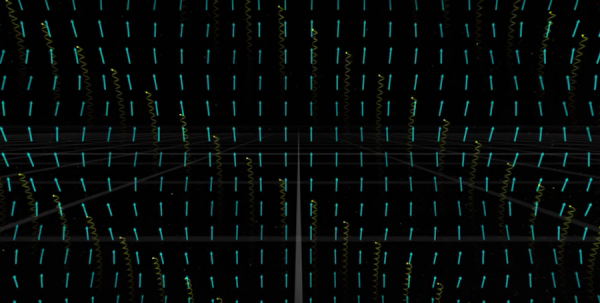By Vishal Goel, | April 08, 2017

In a typical Alfvén wave, the particles (yellow) move freely along the magnetic field lines (blue). (YouTube)
A NASA study has provided observational proof of a 50-year-old plasma wave theory where certain waves act as energy transporters in plasma, which is commonly called the fourth state of matter. The study validated the energy transfer ability of the particle-trapping "kinetic Alfvén wave," revealing small-scale complexities that could reshape our understanding of plasma physics.
Like Us on Facebook
At the time of NASA's Magnetospheric Multiscale (MMS) mission's launch, scientists knew that it would answer questions fundamental to the nature of our universe. The new results, presented in a paper in Nature Communications, are also applicable to nuclear fusion techniques, which rely on minimizing the existence of such waves inside equipment to trap heat efficiently.
It has long been thought that Kinetic Alfvén waves are energy transporters in plasmas throughout the universe. But it is only now that scientists have been able to take a closer look at the microphysics of the waves on the relatively small scales where the energy transfer happens.
The waves were studied on a small scale for the first time because of the unique design of the MMS spacecraft. The MMS's four spacecraft fly in a 3-D pyramid formation, with only four miles between them - closer than ever achieved before and small enough to fit between two wave peaks. With multiple spacecraft, scientists can measure precise details about the wave, such as how fast it moved and in what direction it traveled.
Previous missions flew at much larger separations, which did not allow them to see the small scales - much like trying to measure the thickness of a piece of paper with a yardstick. However, MMS's tight flying formation allowed the spacecraft to investigate the shorter wavelengths of kinetic Alfvén waves.
Some scientists believe that kinetic Alfvén waves are a key to how the solar wind - the constant outpouring of solar particles that sweeps out into space - is heated to extreme temperatures.
-
Use of Coronavirus Pandemic Drones Raises Privacy Concerns: Drones Spread Fear, Local Officials Say

-
Coronavirus Hampers The Delivery Of Lockheed Martin F-35 Stealth Fighters For 2020

-
Instagram Speeds Up Plans to Add Account Memorialization Feature Due to COVID-19 Deaths

-
NASA: Perseverance Plans to Bring 'Mars Rock' to Earth in 2031

-
600 Dead And 3,000 In The Hospital as Iranians Believed Drinking High-Concentrations of Alcohol Can Cure The Coronavirus

-
600 Dead And 3,000 In The Hospital as Iranians Believed Drinking High-Concentrations of Alcohol Can Cure The Coronavirus

-
COVID-19: Doctors, Nurses Use Virtual Reality to Learn New Skills in Treating Coronavirus Patients











